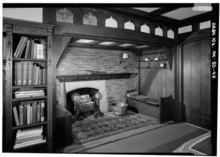
An inglenook or chimney corner is a recess that adjoins a fireplace. The word comes from "ingle", an old Scots word for a domestic fire (derived from the Gaelic aingeal), and "nook".[1][2]
The inglenook originated as a partially enclosed hearth area, appended to a larger room. The hearth was used for cooking, and its enclosing alcove became a natural place for people seeking warmth to gather. With changes in building design, kitchens became separate rooms, while inglenooks were retained in the living space as intimate warming places, subsidiary spaces within larger rooms.[3]
Inglenooks were prominent features of shingle style architecture and characteristic of Arts and Crafts architecture but began to disappear with the advent of central heating.[3][4] Prominent American architects who employed the feature included Greene and Greene, Henry Hobson Richardson, and Frank Lloyd Wright. British architect Richard Norman Shaw significantly influenced Richardson.[5]
- ^ "Ingle". Dictionaries of the Scots Language. Retrieved 20 March 2021.
- ^ "Ingle-nook". Oxford English Dictionary (Online ed.). Oxford University Press. (Subscription or participating institution membership required.)
- ^ a b Holt, Stephen (13 March 2002). "The Inglenook: A History of Hearth & Home". This Old House. Retrieved 17 January 2012.
- ^ "What Was the Arts and Crafts Movement?". Historic England. Retrieved 17 October 2015.
- ^ Flaherty, Carolyn; Conley, Katharine (November 1980). "Cosy Corners". Old-House Journal: 178–179.